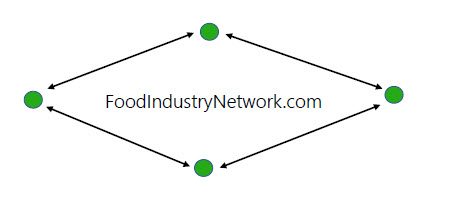Reviews and recommendations are unbiased and products are independently selected. Postmedia may earn an affiliate commission from purchases made through links on this page.
Vancouver International Wine Festival: Explore burgeoning wine culture
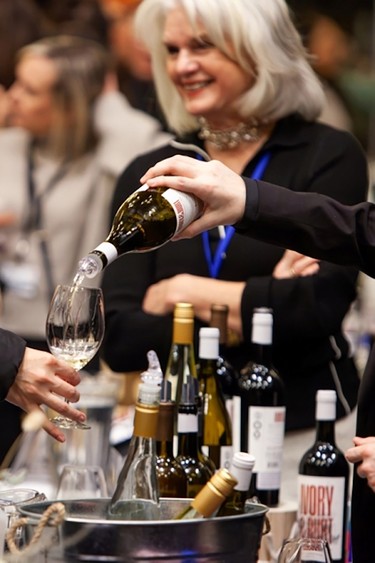
You get to talk face-to-face about the wine in your glass with the people who made it. The Vancouver International Wine Festival is an invaluable experience
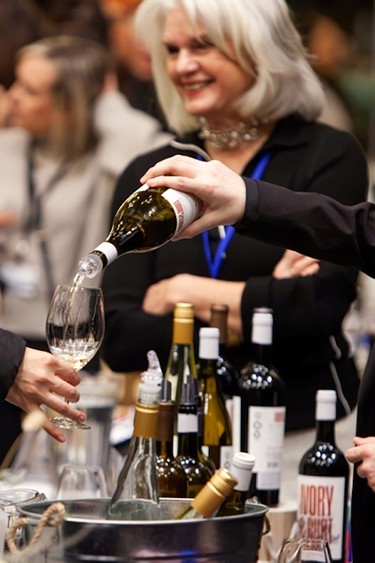
Article content
The Vancouver International Wine Festival turns 46 this year, and having dodged U.S. President Donald Trump’s tariffs for at least another month, it appears it is full speed ahead.
What we know is that along with the U.S. West Coast wineries of California, Oregon, and Washington, there will be 75 other producers from around the world. Given all the uncertainty surrounding the tariff brouhaha, we have focused on the rest of the world, including some of the 20 local producers that will journey to Vancouver. (Read to the end of the story to get the wine checklist.)
Advertisement 2
Article content
It should not be lost on anyone that a large part of the rise in Canadian wine quality and the presence of mind among B.C. wine consumers can be attrxibuted to the festival and its role in developing a strong local wine culture.
Article content
Indeed, many B.C. grape nuts cut their wine knowledge teeth at the festival. After decades of welcoming the international wine world to Vancouver, local producers find themselves in the middle of one of the world’s most diverse and demanding wine markets, and their survival depends on the quality of the wines they are bottling. Today, with over 800-plus wineries nationwide and 13,000 hectares of vines, the possibilities are exciting and seemingly limitless.
Aided by a warming planet and a confident next generation of winegrowers wanting to make wines with a sense of place, we are finally exploring the real potential of Canadian terroir. As someone who tastes wine and has been reporting on it for more than 40 years, I find it easy to say that the jump in the quality of Canadian wine, particularly in the last decade, has been exponential. While I often question the high price of wine today, there is plenty to like about our best labels.
The internet and the ability to travel quickly to most of the world have given us a new cache of knowledge. Before the 1990s, the transfer of information was restricted to one or two generations who were primarily working blind. Two-generation wineries are rare in B.C., so having open access to information from abroad has been crucial to our growth. That said, the next generation will be well-informed about our authentic cool-climate setting.
Advertisement 3
Article content
The week-long show will host winery principals representing 125 wineries from 15 countries across 55 events over eight days.
Anthony Gismondi
Being inside the international tasting room and seeing the competition face-to-face has also been a game-changer for our producers. Watching how foreigners interact with their customers, scanning their labels, and tasting their wines have all played a key part in B.C.’s evolution as a small but elite wine region of place.
Many challenges remain, including catastrophic one-off climate events like the recent deep freeze that damaged many local vineyards. However, resilient growers and producers are working hard to reduce the consequences of such events while making better wine. There is a reason why wine has been around for 8,000 years and likely will be forever.
Once we abandoned the notion that we had to make wine like they do in France, Italy or California, we have permitted ourselves to be different, Canadian, and most importantly, local. For all its ills at the moment, the success of the wine business, as opposed to the success business of wine, is rooted in producing quality local wines at all price levels. We now have a handle on the high end; we need a more concentrated effort to release affordable everyday wines that can compete with the rest of the world.
A quick look at a few local wineries in the room this year begins with two Vancouver Island flagship producers. You will be shocked if you haven’t paid attention to Island Wines. Blue Grouse and Unsworth have dug into the island ethos, not to mention its dirt, and are pouring some of the most truthful wines when it comes to revealing terroir on the continent. Both are focused on Chardonnay, Pinot Noir and sparkling wines.
Advertisement 4
Article content
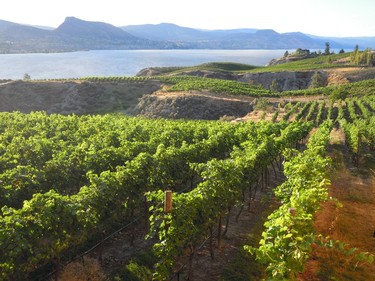
You can’t know every winery in B.C. I’m betting many of you will not know much about the following four producers who will be in the tasting room: Cannon Estate Winery, Mt. Lehman, Fraser Valley, Country Vines Winery, Richmond, Lakeside Cellars on the eastern shores of Lake Osoyoos, and Sage Hayward Vineyards on Saturna Island. Each has a story to tell, and it’s an excellent opportunity to check in and see what they are all about.
The Naramata Bench, the Okanagan Valley sweet spot, will be well represented by Bench 1775, Da Silva Vineyards, La Frenz Estate Winery, Moraine Estate Winery and Poplar Grove Winery. Producers joining them with even deeper heritage roots are Chaberton Estate Winery, Osoyoos Larose, Quails’ Gate Winery, Road 13 Vineyards and Jason Parkes Customs.
The other significant aspect of the international tasting room is that you, the consumer, can compare and contrast wines immediately. You also get to talk face-to-face about the wine in your glass with the people who made it. It is an invaluable experience that, over the past 46 years, has added to the growing patina of British Columbians wine knowledge.
It’s not all Canada at the festival.
The week-long show will host winery principals representing 125 wineries from 15 countries across 55 events over eight days. As always, ticketholders can shop at the onsite B.C. liquor store and buy just about any wine served at the show.
Advertisement 5
Article content
Finally, recent global political events have affected almost everyone, from manufacturers to retailers to consumers. Politics and religion have rarely, if ever, been a topic of discussion inside the festival venues during its 46-year history. Plenty of other platforms are better suited to those discussions, hopefully over a glass of wine. I look forward to seeing you in the tasting room.
For an up-to-the-minute guide of tickets and events still available, visit Vanwinefest.ca.
Inside the international tasting room
Everyone should have a plan of attack by the time they get to the international tasting room, regardless of their level of knowledge or interest in wine. With several hundred wines to taste, themes can be good ideas: Chardonnay, sparkling wine, Cabernet Sauvignon, B.C. Pinot Noir, and, well, there are endless possibilities. After studying the tasting room list, here are some suggestions for spending three hours tasting and spitting your way around the room. All the wines you taste are available for ticket holders to buy at the on-site wine store and can be shipped to the nearest government store to your home.
12 Canadian wines to try at Vancouver International Wine Festival
Advertisement 6
Article content
Picking the best local wines is fast becoming a challenge. Here is a look at some of the do-not-miss local heroes being poured at the festival.
• Blue Grouse Estate 2022 Pinot Noir, Cowichan Valley, Vancouver Island $36
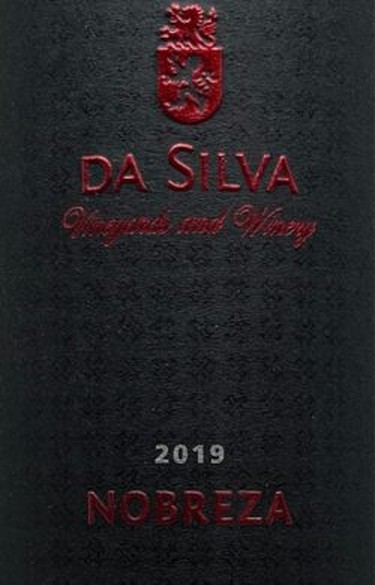
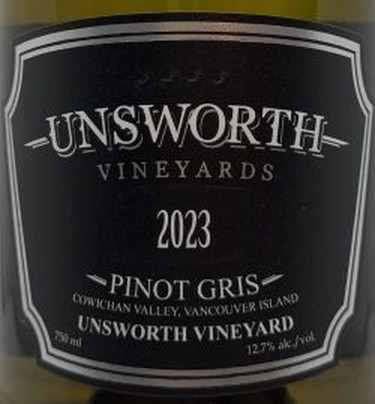
• Da Silva Vineyards 2019 Legado Nobreza, Okanagan Valley, $105
• Frind Sparkling Brut NV, Okanagan Valley, B.C. $29
• Jason Parkes Customs – The Hatch 2020 I’m Your Huckleberry, Okanagan Valley $45
• La Frenz Estate 2022 Desperation Hill Vineyard Pinot Noir, Naramata Bench, Okanagan Valley $31
• Lakeside Cellars 2023 Rosé, South Okanagan Valley $22
• Moraine Estate Winery 2022 Pinot Noir, Naramata Bench $33
• Osoyoos Larose 2020 Le Grand Vin, Okanagan Valley $60
• Phantom Creek Estates 2021 Kobau Syrah Okanagan Valley $68
• Poplar Grove Winery 2020 Cabernet Franc, Okanagan Valley $39
• Quails’ Gate Stewart Family 2022 Reserve Chardonnay, Okanagan Valley $50
• Unsworth Vineyards 2023 Pinot Gris, Cowichan Valley, Vancouver Island $27
13 must-try Pinot Noirs
The world of Pinot Noir is a mystery, led by multiple clones from multiple origins and different soils. Vineyard temperatures are becoming key in a climate-change world, as cooler is better than hotter. The festival has a strong lineup this year, so as you look at each of our recommendations, please find out exactly where the fruit comes from and note the best places for future reference.
Advertisement 7
Article content
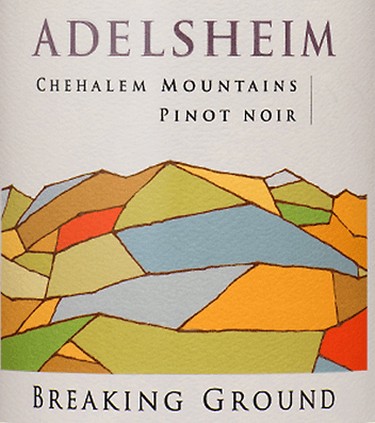
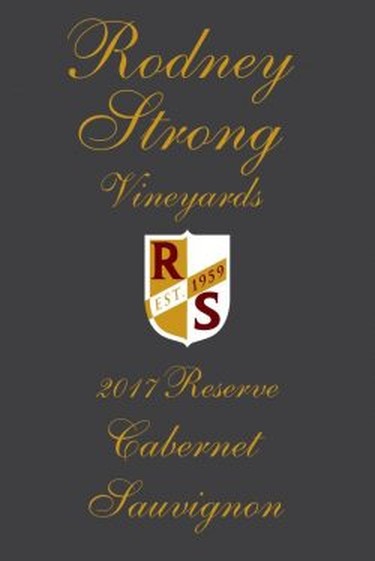
• Baileyana Pinot Noir 2022, Edna Valley, California $39
• Adelsheim Vineyard 2021 Breaking Ground Chehalem Mountains Pinot Noir, Oregon $77
• Aquinas 2018 Pinot Noir, North Coast, California $24
• Calera Central 2023 Coast Pinot Noir, California $53
• Citation Willamette 2015 Valley Pinot Noir, Willamette Valley, Oregon $53
• Erath Willakia Vineyard 2019 Pinot Noir, Eola-Amity Hills, Willamette Valley, Oregon $65
• Emiliana 2023 Signos De Origen Pinot Noir, Colchagua, Chile $30
• Ferrari-Carano 2019 Pinot Noir, Anderson Valley, California $47
• La Crema 2022 Pinot Noir Monterey County, California $33
• Lingua Franca AVNI 2022 Pinot Noir, Wilamette Valley, Oregon $60
• (Josh Cellars) The Calling 2022 Pinot Noir Russian River Valley, Sonoma County, California $60
• Rodney Strong 2020 Pinot Noir Russian River, Sonoma County, California $31
• Talbot Vineyards 2021 Sleepy Hollow Pinot Noir Santa Lucia Highlands, California $36
9 best bright fruit blends
If there is a tonic for sweet red and white blends that tend to dominate wine’s middle market, it may well be the excitement in cool-climate, fresh, exciting whites and reds. Here are some head-turning bottles full of energy and bright fruit.
Advertisement 8
Article content
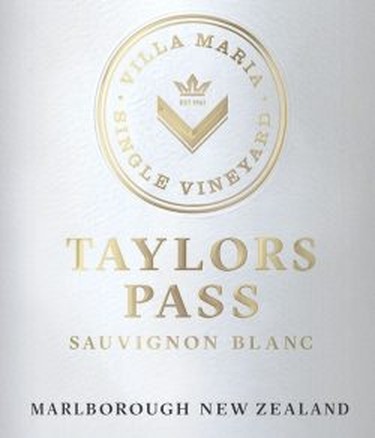
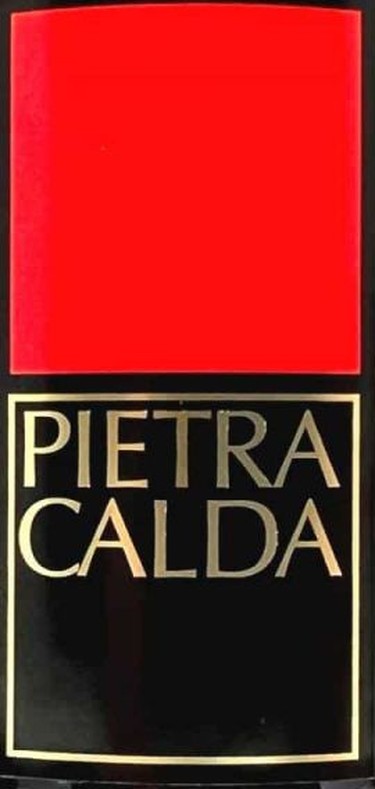
• Anatolikos Vineyards 2022 Fine Assyrtiko Organic $34
• Argyros Santorini Assyrtiko 2022 $48
• Baglio Oro Guari 2023 Inzolia Terre Siciliane, Italy $25
• Bodega Argento 2023 Artesano White Malbec $21
• Cantine Coppi Guiscardo 2022 Falanghina, Puglia, Italy $34
• Feudi di San Gregorio 2022 Fiano Di Avellino Pietracalda, Campania Italy $43
• Pindarie 2021 Small Block Fiano Barossa Valley, Australia $28
• Villa Maria 2023 Single Vineyard Taylors Pass Sauvignon Blanc, Marlborough, New Zealand $30
• Wine Art Estate 2023 Plano Assyrtiko, Drama, Greece $30
17 best Cabernets
The king of red never really disappoints when it’s ripe, and the wine is in balance. There is an extra long list this year, and we couldn’t fit them all in. Here are some labels to look for while wandering the room or at your local wine shop.
• Aquilini Wines, 2021 A56 Cabernet Sauvignon Red Mountain, Washington $85
• Austin 2022 Cabernet Sauvignon, Paso Robles, California $35
• Benziger Family Winery 2022 Cabernet Sauvignon, Sonoma County, California $28
• Black Sage Vineyard 2022 Cabernet Sauvignon, Okanagan Valley, B.C. $33
• Black Stallion Estate 2021 Limited Release Cabernet Sauvignon, Napa Valley $117
• Bonterra Estate Collection 2021 Cabernet Sauvignon, California $35
Advertisement 9
Article content
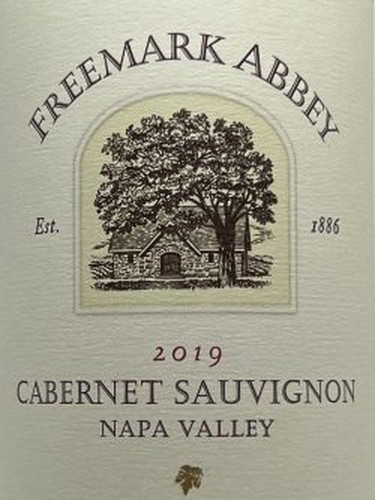

• Chateau Ste. Michelle 2020 Cabernet Sauvignon, Columbia Valley, Washington $25
• Daou 2021 Cabernet Sauvignon, Paso Robles, California $40
• Emiliana 2023 Adobe Reserva Organic Cabernet Sauvignon, Valle Centrale, Chile $15
• Freemark Abbey 2019 Cabernet Sauvignon Napa Valley, California $89
• Majella Wines 2021 Cabernet Sauvignon, Coonawarra, South Australia $35
• Robert Mondavi 2021 Cabernet Sauvignon, Napa Valley, California $70
• Rodney Strong 20217 Reserve Cabernet Sauvignon, Alexander Valley, California $72
• Rombauer Vineyards 2021 Cabernet Sauvignon, Napa Valley, California $129
• S by Signorello 2021 Cabernet Sauvignon, Napa Valley, California $125
• Stags’ Leap Winery 2020 Cabernet Sauvignon, Napa Valley, California $67
• Trentadue Winery 2022 La Storia Cabernet Sauvignon, Alexander Valley, Sonoma County, California $50
12 best booths
Our annual best booths list is an ode to wineries that bring their best Vancouver. Over 40 years, there has been a sea change in the global wine landscape, making it harder and harder to entice top wineries to spend time and money in such a small market. Here’s a list of producers pouring their best in 2025, including one super pick from their lineup. Don’t forget to taste them all.
Advertisement 10
Article content
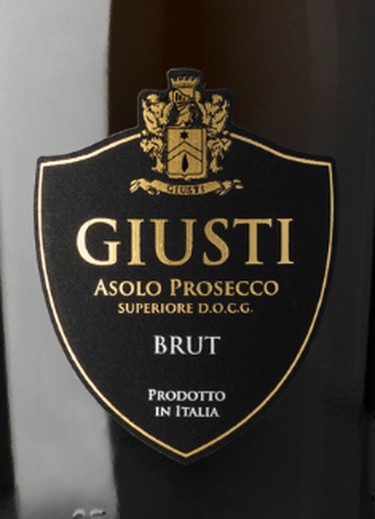
• Anatolikos Vineyards, Thrace, Greece: 2022 Fine Mavroudi of Thrace Organic, Macedonia $56
• Bocale di Valentini, Umbria, Italy: 2018 Montefalco Sagrantino Ennio $96
• Champagne Duval-Leroy, Champagne, France: NV Rosé de Saignee Brut $70
• Emiliana Organic Vineyards, Colchagua, Chile: 2021 Coyam Organic Red Blend $30
• Feudi di San Gregorio, Campania, Italy: 2018 Taurasi $55
• Giusti Wine, Veneto, Italy: NV Prosecco Asolo Brut by Graziana Grassini $40
• Korta Katarina Winery, Croatia: 2023 Pošip $62.99
• Marqués de Riscal, Rioja, Spain: 2019 XR Reserva Rioja $48
• Osoyoos Larose, Osoyoos, B.C.: 2020 Le Grand Vin $60
• Phantom Creek Estates, Okanagan Valley B.C.: 2021 Kobau Syrah $68
• Rocca delle Macìe, Tuscany, Italy: Tenuta Sant’Alfonso 2021 Chianti Classico $38
• Saito Shuzo, Kyoto, Japan: 2024 Koto Sen Nen Junmai Daiginjo Sake $62
Article content

The ultimate West Coast crab cake recipe
From Alaska all the way to California — and especially right here in B.C. — there are few experiences more quintessential to the West Coast than enjoying a Dungeness crab boil.
To do it the traditional way, you should catch the crab yourself, bring a pot of seawater to a boil over a wood fire on a windswept beach, toss some corn, potatoes and seafood spice into the pot, then add a live crab or two or three, and cook for about 15 minutes.
Advertisement 11
Article content
Then gather your friends and crack open the legs and claws to extract the sweet flesh, dip it in drawn butter, and enjoy as the sun sets in a blaze of colour.
Of course, few of us ever actually get to go crabbing, not to mention find a beach that still allows fires, or even enjoy as much crab meat as we’d ever really like to.
Which is why it was such a thrill sitting down to dinner on the opening night of last June’s B.C. Seafood Festival at Mount Washington Alpine Resort. CrabFest’s Kitchen Party, presented by the B.C. Crab Fishermen’s Association, was a good ol’ east-meets-west-coast crab boil complete with fiddle music and — almost — more crab meat than we could eat.
Happily squished in elbow to elbow at the long, gingham-covered tables and armed with crackers and shrimp forks, every single one of us got a bowl stuffed with one and a half Dungeness crabs, along with potatoes, corn and a prawn or two. It was a fabulously messy seafood heaven.
Sweet and Sustainable
From February to April, but mainly in March, Alaskan king crabs start appearing in local restaurants, especially the finer Cantonese dining rooms that specialize in seafood. It’s a momentous occasion. King crabs are the biggest of the crabs, ranging in weight from six to 20 pounds with a leg span that can stretch up to five feet. It’s always a celebration and a fair bit of drama when you order one.
Advertisement 12
Article content
By comparison, Dungeness crabs are tiny, only six to seven inches across and one to four pounds in weight, although most clock in at around two pounds. (A quarter of that is the meat.) But they have a sweet, buttery flavour and delicate texture that is delicious hot or cold, on its own or in a myriad of dishes.
King crab is an event. Dungeness crab is just who we are.
In B.C. and Alaska, Dungeness crab is available year-round, and wild Dungeness crab caught with pots is recommended as “a good alternative” by Ocean Wise. It’s considered slightly less sustainable across the border, where there are concerns about high fishing levels.
If you plan to go crabbing, remember that you will need a fishing licence and crab traps, and you may only keep the males. Alternatively, you can head to your local fish market and select a live crab from a tank.
You can also purchase pre-cooked Dungeness crab meat from your local fishmonger, but you’re looking at $70 to $80 or more a pound, and while it’s much more convenient, it’s never quite as delicious as when it’s cooked fresh.
Like so much local seafood — spot prawns, halibut and the like — Dungeness crab has become something of a delicacy. Luckily, though, a little of it goes a long way.
Advertisement 13
Article content
Versatile and Delicious
Long before Europeans landed on these shores, Indigenous people considered Dungeness crab — what the Coastal Salish called ‘ey’x — a symbol of wisdom and friendship. They enjoyed it both as a reliable source of food (usually boiled in salt water) and in cultural practices such as potlatch ceremonies.
By the middle of the 19th century, the first commercial fishery had opened in San Francisco and soon the Dungeness crab became an essential ingredient in such classic Pacific Northwest dishes as cioppino (a tomato-based, Italian-ish seafood stew), crab Louie (a composed salad topped with loads of crab meat and a dressing similar to Thousand Islands) and even the California roll (before everyone started making it with fake crab meat).
Dungeness crab works beautifully in Asian food, in dumplings like xiao long bao, in spring rolls, in the crisp wontons sometimes called crab Rangoon, or stir-fried with oyster or spicy black bean sauce.
It’s divine stuffed inside ravioli and lavished with a light cream sauce, tossed with linguine, or stirred at the last minute into risotto. It’s beautiful in a quiche or a bisque, all creamy and fragrant with Cognac, garnished with a quenelle of crab meat.
Advertisement 14
Article content
And we love Dungeness crab in a hot, creamy dip, in crab cakes (see recipe), chowder or mixed with a little mayo and tucked into a brioche roll. And adding it to mac and cheese takes comfort food to the next level.
We love pairing it with wine, too — its buttery sweetness and hint of briny minerality make it an excellent partner for Chardonnay, whether it’s the lean cool climate style from Vancouver Island or a rich, opulent Chard from California. But crab meat is also easygoing enough to go with most white and rosé wines, as well as food-friendly lagers and ales.
Most of all, we love it straight from the pot, simply cooked, dipped in butter and shared with good friends. Pass the wine and a big, fat crab claw, and let’s get cracking.
Crab Cakes with Pickled Cucumber and Roasted Jalapeño Tartar Sauce
These delicate crab cakes are pillowy soft and absolutely jam-packed with crabmeat, so it’s best to use sweet, buttery Dungeness crab and to be very gentle when cooking them.
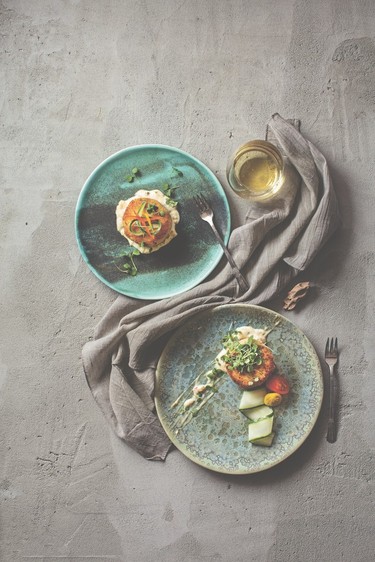
Roasted jalapeño tartar sauce
1 jalapeño pepper
1 tsp canola oil
1 cup mayonnaise
1 tbsp. green relish
Juice of ½ lemon (1 tbsp.)
Preheat oven to 400 F.
Lightly coat the jalapeño with oil and place on a small baking sheet. Roast for 20 minutes, then place in a small bowl. Tightly seal the bowl with plastic wrap and set aside for 1 hour, until cooled to room temperature.
Advertisement 15
Article content
Peel, devein and seed pepper. Chop, then mix it with remaining ingredients. Cover and refrigerate until needed.
Pickled cucumber
1 ½ cups water
1 cup granulated sugar
½ cup white vinegar
1 small English cucumber or 2 Persian cucumbers, thinly sliced
Place water, sugar and vinegar in a saucepan and bring to a simmer. When sugar is dissolved, remove from heat and refrigerate for 1 hour, until chilled. Place cucumber slices in chilled pickling solution in the fridge for at least 1 hour or overnight.
Crab cakes
3 Tbsp unsalted butter (divided)
½ onion, finely chopped
½ red bell pepper, seeded and finely chopped
12 oz fresh Dungeness crabmeat, picked of shells or cartilage
2 tbsp. mayonnaise
1 tbsp. Dijon mustard
1 tbsp. chopped fresh Italian parsley
1 cup panko crumbs (divided)
Preheat oven to 400 F.
Heat 1 tablespoon butter in a small sauté pan over medium heat, add onions and peppers and cook for 7 minutes, until onions are translucent. Set aside to cool.
In a medium bowl, combine crab, mayonnaise, mustard, parsley and onion-pepper mixture and mix gently, trying not to break up the crabmeat.
Add ½ cup panko crumbs and mix until everything binds. Form into 4 cakes and lightly coat each cake with remaining panko.
Advertisement 16
Article content
In a large ovenproof frying pan, heat remaining 2 tablespoons butter over medium heat. Add crab cakes and pan-fry for 5 minutes, turning once very carefully, until golden on both sides. Bake in oven for 8 minutes.
Divide crab cakes between 4 small plates and garnish with pickled cucumbers and a spoonful of roasted jalapeño tartar sauce.
Serves 4.
Excerpted from Vancouver Eats by Joanne Sasvari. Excerpted with permission from Figure 1 Publishing.
Article content
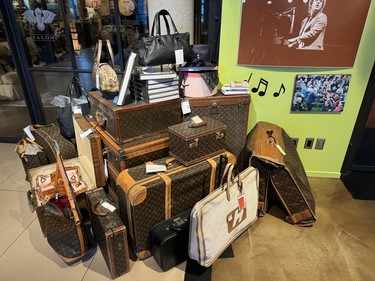
Beyond the wine offerings
The 12-plus months haven’t been easy for the B.C. wine industry.
From a devastating winter freeze to job losses, experts say the struggles of 2024 will continue to be felt in 2025.
“The deep freeze significantly reduced grape yields in the Interior, meaning some B.C. wineries have less product to sell,” says Leeann Froese, owner of Town Hall Brands, a Vancouver-based agency that represents several B.C. wineries and wine organizations.
But within that space of struggle there’s been celebration of some new and ongoing offerings and experiences that aim to bring more business to B.C. wineries.
While boutiques are an important avenue of wine purchasing for most winery properties, the selection at Mission Hill Mission Hill Family Estates stands out as truly unique.
Advertisement 17
Article content
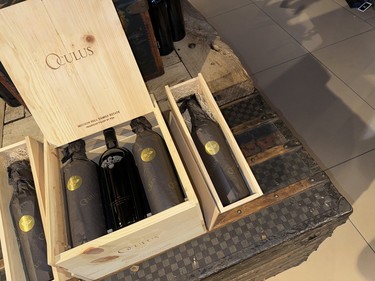
The boutique is filled with extraordinary finds, each with its own unique story.
David Amos
“My approach to sourcing is driven by a commitment to finding what is most beautiful and unique,” says David Amos, merchandising consultant for the winery boutique. “Looking for pieces that seamlessly complement our estate and wines.”
That approach translates to a carefully curated lineup of new and vintage goods sourced from around the globe.
“Sourcing international allows me to bring in rare and exceptional pieces that enhance the Mission Hill experience, but on occasion I find remarkable items close to home,” says Amos.
Among the selection of books, home goods and glassware are vintage luxury handbags and trunks from fashion houses like Louis Vuitton, Goyard and Gucci, pieces that would look more at home in a designer resale store than a winery shop.
“The boutique is filled with extraordinary finds, each with its own unique story,” says Amos of the assemblage, some of which is also available online. “Some pieces are so rare that selling them is bittersweet for me, knowing I probably won’t find another like it.
“One standout is a vase from Notley Abbey, the English country estate of Vivien Leigh and Laurence Olivier, an item with special provenance. As a collector of art myself, I am drawn to items that carry history and meaning, this only enhances the boutique’s ever-changing collection.”
Advertisement 18
Article content
Founded in 1981 by Anthony von Mandl, the winery is known for its wines — Mission Hill’s 2020 Oculus was Canada’s first 100-point red wine — and exceptional on-site food offerings. The vintage luxury boutique offering, Amos says, is perfectly in keeping with the operation’s overarching target of being a lifestyle brand.
“Integrating vintage pieces into the boutique enhances this vision, offering guests a unique journey,” says Amos. “Retail of this level is exceptionally difficult to achieve and maintain, but it reflects our dedication to legacy, beauty, and distinctive offerings.”
Further south in the Okanagan, in Summerland, another popular wine experience continues to gain steam.
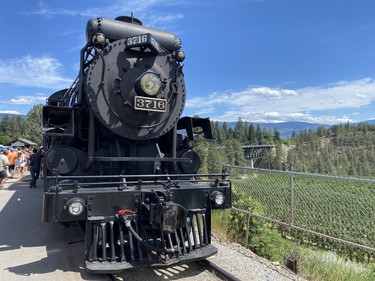
The Grand Sommelier Express offers an opportunity for wine fans to depart from the usual wine tasting experience. Held aboard a restored steam locomotive, which dates to 1912, the wine train features wine tastings, craft beers and ciders, live music, appetizers and more.
This year, the event will run 30 minutes longer, with the goal of providing a more “relaxed pace” to the tasting experience.
“It’s one of a kind and an important signature event for our members to showcase their products,” says Christine Coletta, owner of Haywire Winery and a member of the Bottleneck Drive association, which holds the event in partnership with the Kettle Valley Railway.
Advertisement 19
Article content
This year’s train departs on June 20. Tickets are priced at $169 per person, plus GST and fees, and are available online but sell out quickly.
Down in the Fraser Valley, Singletree Winery is looking to shake up its winery experience with unique property additions.
The family owned winery introduced tasting domes, which it calls DiVine Domes, in 2020 as a pandemic project. The socially distanced wine tasting experience, which features two themes Enchanted Forest, and Canadian Cabin, proved impressively popular with guests. When the domes first launched, the winery team notes, the interest was so high the website crashed.
“The Domes and Cabanas have really helped our winery and has been a special experience for our guests,” says owner Debbie Etsell. “With the many challenges over the last few years, COVID and higher inflation, the consumer has been looking for something that transports them to a place of enjoyment, peacefulness and something different from their everyday lives.”
The Singletree team has since introduced a virtual reservation system in order to handle the demand. And, fast forward to 2025, and Singletree has also added “wine cabanas,” cosy cabin-like structures with just enough room for two.
According to B.C. wine insiders, these and other out-of-the-bottle experiences and offerings have become essential elements of business.
“Experiential offerings help diversify revenue streams, encouraging guests to spend differently per visit through premium tastings, add-ons like food pairings, and bookable experiences,” says Froese. “This model helps wineries maintain profitability even when bottle sales are impacted.”
Article content
Source: vancouversun.com

